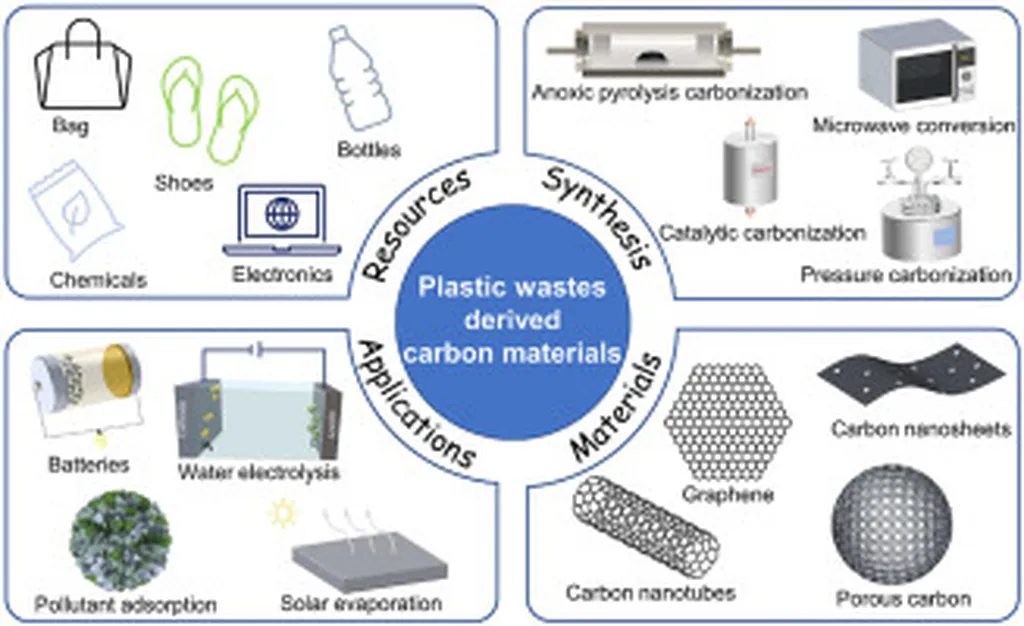In a significant stride towards sustainable energy solutions, researchers have developed an innovative method to transform waste polyvinyl chloride (PVC) into high-performance porous carbon materials for supercapacitors. This breakthrough, published in the journal *Molecules* (which translates to “Molecules” in English), offers a green approach to recycling PVC waste while advancing the development of efficient energy storage devices.
The study, led by Wenbo Cai from the Institute of Advanced Wear & Corrosion Resistant and Functional Materials at Jinan University in Guangzhou, China, introduces a dual-activation process that converts PVC waste into hierarchical porous carbon. The method involves pre-activation with calcium carbonate (CaCO₃) to capture hydrochloric acid (HCl) and form meso/macroporous frameworks, followed by potassium hydroxide (KOH) activation to fine-tune the microporosity. This dual-purpose approach not only addresses the environmental challenge of PVC waste but also paves the way for high-performance electrodes in supercapacitors.
“Our method effectively captures the HCl released during the pyrolysis of PVC, preventing environmental pollution and simultaneously creating a porous structure that enhances the material’s performance,” explained Cai. The researchers systematically investigated the effects of varying KOH loading ratios on the primary activated carbon material. They found that a ratio of 1:2 (C-PVC:KOH) yielded optimal properties, with a specific surface area of 1729 m²/g and an oxygen doping content of 7.37%.
Electrochemical measurements revealed that the optimized material, designated as C-KOH-2, exhibited a high specific capacitance of 360.4 F/g at 1 A/g, retaining 72.1% of its capacitance at 10 A/g. The symmetric supercapacitors achieved an energy density of 9.9 Wh/kg at 125 W/kg, with impressive capacitance retention of 93.12% over 5000 cycles. These results highlight the potential of upcycled PVC waste as a viable and sustainable material for energy storage applications.
The commercial implications of this research are substantial. Supercapacitors are increasingly being integrated into renewable energy systems, electric vehicles, and portable electronics due to their rapid charge-discharge capabilities and long cycle life. The ability to produce high-performance electrodes from waste PVC not only reduces environmental pollution but also lowers the cost of supercapacitor production. This dual benefit could accelerate the adoption of supercapacitors in various industries, contributing to a more sustainable energy future.
As the world grapples with the challenges of plastic waste and the transition to renewable energy, innovative solutions like this one are crucial. “This research demonstrates the potential of chemical recycling to transform waste materials into valuable resources,” said Cai. “By upcycling PVC waste, we can contribute to a circular economy and support the development of advanced energy storage technologies.”
The study’s findings open new avenues for research and development in the field of energy storage. Future work could explore the scalability of the process and the integration of these materials into commercial supercapacitor systems. Additionally, the dual-activation method could be adapted for other types of plastic waste, further expanding the scope of sustainable energy solutions.
In conclusion, this research represents a significant step forward in the quest for sustainable energy storage solutions. By converting waste PVC into high-performance porous carbon materials, the study not only addresses environmental concerns but also offers a promising path towards more efficient and cost-effective supercapacitors. As the energy sector continues to evolve, such innovations will play a pivotal role in shaping a greener and more sustainable future.

